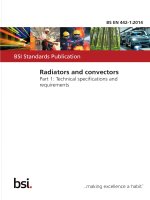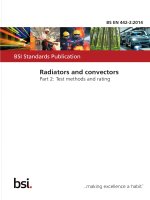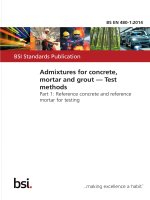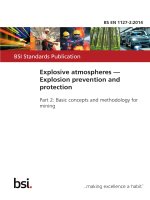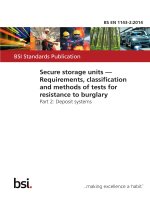Bsi bs en 62386 102 2014
Bạn đang xem bản rút gọn của tài liệu. Xem và tải ngay bản đầy đủ của tài liệu tại đây (3.17 MB, 292 trang )
BS EN 62386-102:2014
BSI Standards Publication
Digital addressable
lighting interface
Part 102: General requirements —
Control gear
BRITISH STANDARD
BS EN 62386-102:2014
National foreword
This British Standard is the UK implementation of EN 62386-102:2014. It is
identical to IEC 62386-102:2014. It supersedes BS EN 62386-102:2009, which
will be withdrawn on 12 December 2017.
The UK participation in its preparation was entrusted by Technical
Committee CPL/34, Lamps and Related Equipment, to Subcommittee
CPL/34/3, Auxiliaries for lamps.
A list of organizations represented on this committee can be obtained on
request to its secretary.
This publication does not purport to include all the necessary provisions of
a contract. Users are responsible for its correct application.
© The British Standards Institution 2015
Published by BSI Standards Limited 2015.
ISBN 978 0 580 82523 1
ICS 29.140.99; 29.140.50
Compliance with a British Standard cannot confer immunity from
legal obligations.
This British Standard was published under the authority of the
Standards Policy and Strategy Committee on 31 January 2015.
Amendments/corrigenda issued since publication
Date
Text affected
EUROPEAN STANDARD
EN 62386-102
NORME EUROPÉENNE
EUROPÄISCHE NORM
December 2014
ICS 29.140; 29.140.50
Supersedes EN 62386-102:2009
English Version
Digital addressable lighting interface Part 102: General requirements - Control gear
(IEC 62386-102:2014)
Interface d'éclairage adressable numérique Partie 102: Exigences générales - Appareillages de
commande
(CEI 62386-102:2014)
Digital adressierbare Schnittstelle für die Beleuchtung Teil 102: Allgemeine Anforderungen - Betriebsgeräte
(IEC 62386-102:2014)
This European Standard was approved by CENELEC on 2014-12-12. CENELEC members are bound to comply with the CEN/CENELEC
Internal Regulations which stipulate the conditions for giving this European Standard the status of a national standard without any alteration.
Up-to-date lists and bibliographical references concerning such national standards may be obtained on application to the CEN-CENELEC
Management Centre or to any CENELEC member.
This European Standard exists in three official versions (English, French, German). A version in any other language made by translation
under the responsibility of a CENELEC member into its own language and notified to the CEN-CENELEC Management Centre has the
same status as the official versions.
CENELEC members are the national electrotechnical committees of Austria, Belgium, Bulgaria, Croatia, Cyprus, the Czech Republic,
Denmark, Estonia, Finland, Former Yugoslav Republic of Macedonia, France, Germany, Greece, Hungary, Iceland, Ireland, Italy, Latvia,
Lithuania, Luxembourg, Malta, the Netherlands, Norway, Poland, Portugal, Romania, Slovakia, Slovenia, Spain, Sweden, Switzerland,
Turkey and the United Kingdom.
European Committee for Electrotechnical Standardization
Comité Européen de Normalisation Electrotechnique
Europäisches Komitee für Elektrotechnische Normung
CEN-CENELEC Management Centre: Avenue Marnix 17, B-1000 Brussels
© 2014 CENELEC All rights of exploitation in any form and by any means reserved worldwide for CENELEC Members.
Ref. No. EN 62386-102:2014 E
BS EN 62386-102:2014
EN 62386-102:2014
-2-
Foreword
The text of document 34C/1099/FDIS, future edition 2 of IEC 62386-102, prepared by
SC 34C "Auxiliaries for lamps" of IEC/TC 34 "Lamps and related equipment" was submitted to the
IEC-CENELEC parallel vote and approved by CENELEC as EN 62386-102:2014.
The following dates are fixed:
•
latest date by which the document has to be
implemented at national level by
publication of an identical national
standard or by endorsement
(dop)
2015-09-12
•
latest date by which the national
standards conflicting with the
document have to be withdrawn
(dow)
2017-12-12
This document supersedes EN 62386-102:2009.
Attention is drawn to the possibility that some of the elements of this document may be the subject of
patent rights. CENELEC [and/or CEN] shall not be held responsible for identifying any or all such
patent rights.
Endorsement notice
The text of the International Standard IEC 62386-102:2014 was approved by CENELEC as a
European Standard without any modification.
In the official version, for Bibliography, the following notes have to be added for the standards indicated:
IEC 60598-1
NOTE
Harmonized as EN 60598-1.
IEC 60669-2-1
NOTE
Harmonized as EN 60669-2-1.
IEC 60921
NOTE
Harmonized as EN 60921.
NOTE
Harmonized as EN 60923.
NOTE
Harmonized as EN 60925 .
IEC 61547
NOTE
Harmonized as EN 61547.
IEC 62386-102:2009
NOTE
Harmonized as EN 62386-102:2009.
CISPR 15
NOTE
Harmonized as EN 55015.
IEC 60923
IEC 60925
1)
1)
Withdrawn publication.
1)
BS EN 62386-102:2014
EN 62386-102:2014
-3-
Annex ZA
(normative)
Normative references to international publications
with their corresponding European publications
The following documents, in whole or in part, are normatively referenced in this document and are
indispensable for its application. For dated references, only the edition cited applies. For undated
references, the latest edition of the referenced document (including any amendments) applies.
NOTE 1 When an International Publication has been modified by common modifications, indicated by (mod), the relevant
EN/HD applies.
NOTE 2 Up-to-date information on the latest versions of the European Standards listed in this annex is available here:
www.cenelec.eu
Publication
Year
Title
EN/HD
Year
IEC 61347
Series
Lamp controlgear
EN 61347
Series
IEC 62386-101
2014
Digital addressable lighting interface EN 62386-101
Part 101: General requirements - System
Components
2014
IEC 62386-103
2014
Digital addressable lighting interface Part 103: General requirements - Control
devices
2014
EN 62386-103
–2–
BS EN 62386-102:2014
IEC 62386-102:2014 © IEC 2014
CONTENTS
INTRODUCTION ................................................................................................................... 14
1
Scope ............................................................................................................................ 15
2
Normative references .................................................................................................... 15
3
Terms and definitions .................................................................................................... 15
4
General ......................................................................................................................... 18
4.1
General ................................................................................................................. 18
4.2
Version number .................................................................................................... 18
5
Electrical specification ................................................................................................... 18
6
Interface power supply .................................................................................................. 18
7
Transmission protocol structure ..................................................................................... 19
7.1
General ................................................................................................................. 19
7.2
16 bit forward frame encoding ............................................................................... 19
7.2.1
General ......................................................................................................... 19
7.2.2
Address byte ................................................................................................. 19
7.2.3
Opcode byte .................................................................................................. 19
Timing ........................................................................................................................... 19
8
9
Method of operation ....................................................................................................... 20
9.1
9.2
9.3
9.4
9.5
9.5.1
9.5.2
9.5.3
9.5.4
9.5.5
9.5.6
9.5.7
9.5.8
9.5.9
9.6
9.7
9.7.1
9.7.2
9.7.3
9.7.4
9.7.5
9.7.6
9.7.7
9.8
9.8.1
9.8.2
9.8.3
General ................................................................................................................. 20
Control gear .......................................................................................................... 20
Dimming curve ...................................................................................................... 20
Calculating “targetLevel” ....................................................................................... 23
Fading .................................................................................................................. 23
General ......................................................................................................... 23
Fade time ...................................................................................................... 24
Fade rate ....................................................................................................... 25
Extended fade time ........................................................................................ 26
Using the fade time ........................................................................................ 28
Using the fade rate ........................................................................................ 28
Behaviour during a fade ................................................................................. 28
Behaviour during startup ................................................................................ 28
Stopping a fade ............................................................................................. 28
Min and max level ................................................................................................. 29
Commands ........................................................................................................... 29
General ......................................................................................................... 29
Level instructions without fade ....................................................................... 30
Level instructions initiating a fade .................................................................. 30
Configuration instructions .............................................................................. 30
Queries ......................................................................................................... 30
Special commands ........................................................................................ 31
Application extended commands.................................................................... 31
Command iterations .............................................................................................. 31
General ......................................................................................................... 31
Command iteration of “UP” and “DOWN” commands ...................................... 31
DAPC SEQUENCE (deprecated) ................................................................... 31
BS EN 62386-102:2014
IEC 62386-102:2014 © IEC 2014
–3–
9.9
Modes of operation ............................................................................................... 32
9.9.1
General ......................................................................................................... 32
9.9.2
Operating mode 0x00: standard mode ........................................................... 32
9.9.3
Operating mode 0x01 to 0x7F: reserved ........................................................ 32
9.9.4
Operating mode 0x80 to 0xFF: manufacturer specific modes ......................... 32
9.10 Memory banks ...................................................................................................... 33
9.10.1
General ......................................................................................................... 33
9.10.2
Memory map .................................................................................................. 33
9.10.3
Selecting a memory bank location ................................................................. 34
9.10.4
Memory bank reading .................................................................................... 34
9.10.5
Memory bank writing ...................................................................................... 34
9.10.6
Memory bank 0 .............................................................................................. 35
9.10.7
Memory bank 1 .............................................................................................. 37
9.10.8
Manufacturer specific memory banks ............................................................. 39
9.10.9
Reserved memory banks ............................................................................... 39
9.11 Reset .................................................................................................................... 39
9.11.1
Reset operation ............................................................................................. 39
9.11.2
Reset memory bank operation ....................................................................... 39
9.12 System failure ....................................................................................................... 39
9.13 Power on .............................................................................................................. 40
9.14 Assigning short addresses .................................................................................... 41
9.14.1
General ......................................................................................................... 41
9.14.2
Random address allocation ............................................................................ 41
9.14.3
Identification of a device ................................................................................ 42
9.14.4
Direct address allocation ............................................................................... 43
9.15 Failure state behaviour ......................................................................................... 43
9.16 Status information ................................................................................................. 43
9.16.1
General ......................................................................................................... 43
9.16.2
Bit 0: Control gear failure ............................................................................... 43
9.16.3
Bit 1: Lamp failure ......................................................................................... 44
9.16.4
Bit 2: Lamp on ............................................................................................... 44
9.16.5
Bit 3: Limit error ............................................................................................. 44
9.16.6
Bit 4: Fade running ........................................................................................ 44
9.16.7
Bit 5: Reset state ........................................................................................... 44
9.16.8
Bit 6: Missing short address ........................................................................... 44
9.16.9
Bit 7: Power cycle seen ................................................................................. 45
9.17 Non-volatile memory ............................................................................................. 45
9.18 Device types and features ..................................................................................... 45
9.19 Using scenes ........................................................................................................ 46
10 Declaration of variables ................................................................................................. 47
11
Definition of commands ................................................................................................. 49
11.1 General ................................................................................................................. 49
11.2 Overview Sheets ................................................................................................... 49
11.3 Level instructions .................................................................................................. 55
11.3.1
DAPC (level) .................................................................................................. 55
11.3.2
OFF ............................................................................................................... 55
11.3.3
UP ................................................................................................................. 55
11.3.4
DOWN ........................................................................................................... 55
11.3.5
STEP UP ....................................................................................................... 55
–4–
BS EN 62386-102:2014
IEC 62386-102:2014 © IEC 2014
11.3.6
STEP DOWN ................................................................................................. 56
11.3.7
RECALL MAX LEVEL .................................................................................... 56
11.3.8
RECALL MIN LEVEL ..................................................................................... 56
11.3.9
STEP DOWN AND OFF ................................................................................. 57
11.3.10 ON AND STEP UP ......................................................................................... 57
11.3.11 ENABLE DAPC SEQUENCE .......................................................................... 57
11.3.12 GO TO LAST ACTIVE LEVEL ........................................................................ 58
11.3.13 GO TO SCENE (sceneNumber) ........................................................................ 58
11.4 Configuration instructions ..................................................................................... 58
11.4.1
General ......................................................................................................... 58
11.4.2
RESET .......................................................................................................... 58
11.4.3
STORE ACTUAL LEVEL IN DTR0 ................................................................. 58
11.4.4
SAVE PERSISTENT VARIABLES .................................................................. 58
11.4.5
SET OPERATING MODE (DTR0) ................................................................... 59
11.4.6
RESET MEMORY BANK (DTR0) .................................................................... 59
11.4.7
IDENTIFY DEVICE ........................................................................................ 59
11.4.8
SET MAX LEVEL (DTR0) ............................................................................... 60
11.4.9
SET MIN LEVEL (DTR0) ................................................................................ 60
11.4.10 SET SYSTEM FAILURE LEVEL (DTR0) ......................................................... 60
11.4.11 SET POWER ON LEVEL (DTR0) .................................................................... 61
11.4.12 SET FADE TIME (DTR0) ................................................................................ 61
11.4.13 SET FADE RATE (DTR0) ............................................................................... 61
11.4.14 SET EXTENDED FADE TIME (DTR0) ............................................................. 61
11.4.15 SET SCENE (DTR0, sceneX) ........................................................................... 62
11.4.16 REMOVE FROM SCENE (sceneX) .................................................................. 62
11.4.17 ADD TO GROUP (group) ................................................................................ 62
11.4.18 REMOVE FROM GROUP (group) ................................................................... 62
11.4.19 SET SHORT ADDRESS (DTR0) ..................................................................... 62
11.4.20 ENABLE WRITE MEMORY ............................................................................ 63
11.5 Queries ................................................................................................................. 63
11.5.1
General ......................................................................................................... 63
11.5.2
QUERY STATUS ........................................................................................... 63
11.5.3
QUERY CONTROL GEAR PRESENT ............................................................ 63
11.5.4
QUERY CONTROL GEAR FAILURE .............................................................. 63
11.5.5
QUERY LAMP FAILURE ................................................................................ 63
11.5.6
QUERY LAMP POWER ON ........................................................................... 63
11.5.7
QUERY LIMIT ERROR .................................................................................. 63
11.5.8
QUERY RESET STATE ................................................................................. 63
11.5.9
QUERY MISSING SHORT ADDRESS ............................................................ 63
11.5.10 QUERY VERSION NUMBER .......................................................................... 64
11.5.11 QUERY CONTENT DTR0 .............................................................................. 64
11.5.12 QUERY DEVICE TYPE .................................................................................. 64
11.5.13 QUERY NEXT DEVICE TYPE ........................................................................ 64
11.5.14 QUERY PHYSICAL MINIMUM ....................................................................... 64
11.5.15 QUERY POWER FAILURE ............................................................................ 64
11.5.16 QUERY CONTENT DTR1 .............................................................................. 64
11.5.17 QUERY CONTENT DTR2 .............................................................................. 64
11.5.18 QUERY OPERATING MODE ......................................................................... 65
11.5.19 QUERY LIGHT SOURCE TYPE ..................................................................... 65
BS EN 62386-102:2014
IEC 62386-102:2014 © IEC 2014
–5–
11.5.20 QUERY ACTUAL LEVEL ............................................................................... 65
11.5.21 QUERY MAX LEVEL ...................................................................................... 65
11.5.22 QUERY MIN LEVEL ....................................................................................... 66
11.5.23 QUERY POWER ON LEVEL .......................................................................... 66
11.5.24 QUERY SYSTEM FAILURE LEVEL ............................................................... 66
11.5.25 QUERY FADE TIME/FADE RATE .................................................................. 66
11.5.26 QUERY EXTENDED FADE TIME ................................................................... 66
11.5.27 QUERY MANUFACTURER SPECIFIC MODE ................................................ 66
11.5.28 QUERY SCENE LEVEL (sceneX) .................................................................... 66
11.5.29 QUERY GROUPS 0-7 .................................................................................... 66
11.5.30 QUERY GROUPS 8-15 .................................................................................. 66
11.5.31 QUERY RANDOM ADDRESS (H) .................................................................. 67
11.5.32 QUERY RANDOM ADDRESS (M) .................................................................. 67
11.5.33 QUERY RANDOM ADDRESS (L) ................................................................... 67
11.5.34 READ MEMORY LOCATION (DTR1, DTR0) .................................................... 67
11.6 Application extended commands ........................................................................... 67
11.6.1
General ......................................................................................................... 67
11.6.2
QUERY EXTENDED VERSION NUMBER ...................................................... 67
11.7 Special commands ................................................................................................ 68
11.7.1
General ......................................................................................................... 68
11.7.2
TERMINATE .................................................................................................. 68
11.7.3
DTR0 (data) ................................................................................................... 68
11.7.4
INITIALISE (device) ........................................................................................ 68
11.7.5
RANDOMISE ................................................................................................. 68
11.7.6
COMPARE .................................................................................................... 69
11.7.7
WITHDRAW ................................................................................................... 69
11.7.8
SEARCHADDRH (data) .................................................................................. 69
11.7.9
SEARCHADDRM (data) ................................................................................. 69
11.7.10 SEARCHADDRL (data) .................................................................................. 69
11.7.11 PROGRAM SHORT ADDRESS (data) ............................................................ 70
11.7.12 VERIFY SHORT ADDRESS (data) ................................................................. 70
11.7.13 QUERY SHORT ADDRESS ........................................................................... 70
11.7.14 ENABLE DEVICE TYPE (data) ....................................................................... 70
11.7.15 DTR1 (data) ................................................................................................... 71
11.7.16 DTR2 (data) ................................................................................................... 71
11.7.17 WRITE MEMORY LOCATION (DTR1, DTR0, data) .......................................... 71
11.7.18 WRITE MEMORY LOCATION – NO REPLY (DTR1, DTR0, data) ..................... 71
11.7.19 PING ............................................................................................................. 72
12 Test procedures ............................................................................................................ 72
12.1 General notes on test............................................................................................ 72
12.1.1
Abbreviations................................................................................................. 72
12.1.2
Test execution ............................................................................................... 72
12.1.3
Data transmission .......................................................................................... 72
12.1.4
Test setup ..................................................................................................... 73
12.1.5
Test output .................................................................................................... 73
12.1.6
Fade time measurements based on light output ............................................. 73
12.1.7
Description of test scheme for fast fade times on PWM dimmer ..................... 74
12.1.8
Test notation ................................................................................................. 75
12.1.9
Test execution limitation ................................................................................ 75
–6–
BS EN 62386-102:2014
IEC 62386-102:2014 © IEC 2014
12.1.10 Test results ................................................................................................... 75
12.1.11 Exception handling ........................................................................................ 75
12.1.12 Unexpected answer ....................................................................................... 75
12.2 Preamble .............................................................................................................. 77
12.2.1
Test preamble ............................................................................................... 77
12.3 Physical operational parameters ........................................................................... 94
12.3.1
Polarity test ................................................................................................... 94
12.3.2
Maximum and minimum system voltage ......................................................... 94
12.3.3
Overvoltage protection test ............................................................................ 95
12.3.4
Current rating test.......................................................................................... 96
12.3.5
Transmitter voltages ...................................................................................... 97
12.3.6
Transmitter rising and falling edges ............................................................... 99
12.3.7
Transmitter bit timing ................................................................................... 101
12.3.8
Transmitter frame timing .............................................................................. 103
12.3.9
Receiver start-up behavior ........................................................................... 104
12.3.10 Receiver threshold ....................................................................................... 105
12.3.11 Receiver bit timing ....................................................................................... 106
12.3.12 Extended receiver bit timing ........................................................................ 110
12.3.13 Receiver forward frame violation.................................................................. 112
12.3.14 Receiver settling timing ............................................................................... 112
12.3.15 Receiver frame timing FF-FF send twice ...................................................... 113
12.4 Configuration instructions ................................................................................... 115
12.4.1
RESET ........................................................................................................ 115
12.4.2
RESET: timeout / command in-between ....................................................... 119
12.4.3
Send-twice timeout ...................................................................................... 121
12.4.4
Commands in-between ................................................................................ 129
12.4.5
STORE ACTUAL LEVEL IN DTR0 ............................................................... 135
12.4.6
SAVE PERSISTENT VARIABLES ................................................................ 136
12.4.7
SET OPERATING MODE ............................................................................. 136
12.4.8
SET MAX LEVEL ......................................................................................... 137
12.4.9
SET MIN LEVEL .......................................................................................... 137
12.4.10 SET SYSTEM FAILURE LEVEL ................................................................... 138
12.4.11 SET POWER ON LEVEL ............................................................................. 139
12.4.12 SET FADE TIME .......................................................................................... 143
12.4.13 SET FADE RATE ......................................................................................... 143
12.4.14 SET SCENE / REMOVE FROM SCENE ....................................................... 144
12.4.15 ADD TO GROUP / REMOVE FROM GROUP ............................................... 145
12.4.16 SET SHORT ADDRESS ............................................................................... 146
12.4.17 SET EXTENDED FADE TIME ...................................................................... 147
12.4.18 Reset/Power-on values ................................................................................ 148
12.4.19 DTR0 / DTR1 / DTR2 ................................................................................... 154
12.5 Memory banks .................................................................................................... 154
12.5.1
READ MEMORY LOCATION on Memory Bank 0 .......................................... 154
12.5.2
READ MEMORY LOCATION on Memory Bank 1 .......................................... 159
12.5.3
READ MEMORY LOCATION on other Memory Banks .................................. 161
12.5.4
Memory bank writing .................................................................................... 163
12.5.5
ENABLE WRITE MEMORY: writeEnableState .............................................. 168
12.5.6
ENABLE WRITE MEMORY: timeout / command in-between ......................... 171
12.5.7
RESET MEMORY BANK: timeout / command in-between ............................ 172
BS EN 62386-102:2014
IEC 62386-102:2014 © IEC 2014
–7–
12.5.8
RESET MEMORY BANK .............................................................................. 175
12.6 Level instructions ................................................................................................ 176
12.6.1
Level instructions: Basic behaviour .............................................................. 176
12.6.2
FADE TIME: possible values ....................................................................... 181
12.6.3
FADE TIME: transitions ............................................................................... 182
12.6.4
FADE TIME: fading to 0 ............................................................................... 184
12.6.5
FADE TIME: small steps fading ................................................................... 186
12.6.6
FADE TIME: extended fade time .................................................................. 189
12.6.7
FADE RATE: possible values ....................................................................... 191
12.6.8
FADE RATE: transitions .............................................................................. 194
12.6.9
FADE RATE: extended fade time ................................................................. 195
12.6.10 FADE TIME/FADE RATE: stop fading by setting MIN/MAX levels ................ 196
12.6.11 FADE TIME/FADE RATE: stop fading .......................................................... 201
12.6.12 FADE TIME/FADE RATE: stop fading when a command is sent, check
timing .......................................................................................................... 204
12.6.13 FADE TIME/FADE RATE: stop fading during startup .................................... 210
12.6.14 Level instructions: combined instructions ..................................................... 211
12.6.15 Power On Level - System Failure Level combined ....................................... 213
12.6.16 ENABLE DAPC SEQUENCE ........................................................................ 218
12.6.17 GO TO LAST ACTIVE LEVEL ...................................................................... 219
12.6.18 GO TO SCENE ............................................................................................ 221
12.6.19 Power on: level control commands............................................................... 222
12.6.20 Logarithmic dimming curve .......................................................................... 224
12.6.21 Dimming curve: DAPC ................................................................................. 225
12.6.22 Dimming curve: UP / DOWN ........................................................................ 226
12.6.23 Dimming curve: STEP UP / STEP DOWN .................................................... 227
12.6.24 FADE TIME/EXTENDED FADE TIME: light output behaviour ....................... 228
12.6.25 EXTENDED FADE TIME: light output behaviour .......................................... 229
12.6.26 Behaviour during a fade ............................................................................... 230
12.7 Special commands .............................................................................................. 232
12.7.1
INITIALISE – timer ....................................................................................... 232
12.7.2
TERMINATE ................................................................................................ 234
12.7.3
INITIALISE - device addressing ................................................................... 234
12.7.4
RANDOMISE ............................................................................................... 235
12.7.5
COMPARE .................................................................................................. 236
12.7.6
WITHDRAW ................................................................................................. 237
12.7.7
SEARCHADDRH / SEARCHADDRM / SEARCHADDRL ............................... 238
12.7.8
PROGRAM SHORT ADDRESS .................................................................... 239
12.7.9
VERIFY SHORT ADDRESS ......................................................................... 241
12.7.10 QUERY SHORT ADDRESS ......................................................................... 242
12.7.11 IDENTIFY DEVICE ...................................................................................... 244
12.7.12 IDENTIFY DEVICE THROUGH RECALL MIN/MAX LEVEL ........................... 246
12.8 Queries and reserved commands ........................................................................ 250
12.8.1
QUERY STATUS - lampFailure/lampOn ....................................................... 250
12.8.2
QUERY STATUS - lampOn .......................................................................... 253
12.8.3
QUERY STATUS - limitError/lampOn ........................................................... 254
12.8.4
QUERY STATUS - powerCycleSeen ............................................................ 258
12.8.5
QUERY CONTROL GEAR PRESENT .......................................................... 259
12.8.6
QUERY VERSION NUMBER ........................................................................ 259
–8–
BS EN 62386-102:2014
IEC 62386-102:2014 © IEC 2014
12.8.7
PING ........................................................................................................... 260
12.8.8
Broadcast unaddressed ............................................................................... 260
12.8.9
Reserved commands: standard commands .................................................. 262
12.8.10 Reserved commands: special commands .................................................... 262
12.8.11 Application extended commands.................................................................. 263
12.8.12 Not supported device types ......................................................................... 264
12.8.13 Removed functionality ................................................................................. 264
12.9 Cross contamination ........................................................................................... 266
12.9.1
DTR0 ........................................................................................................... 266
12.9.2
NVM variables ............................................................................................. 266
12.9.3
Random address generation ........................................................................ 268
12.9.4
Addressing 1 ............................................................................................... 269
12.9.5
Addressing 2 ............................................................................................... 270
12.9.6
Addressing 3 ............................................................................................... 272
12.10 General subsequences ....................................................................................... 273
12.10.1 GetVersionNumber ...................................................................................... 273
12.10.2 GetExtendedVersionNumber ........................................................................ 273
12.10.3 GetSupportedDeviceTypes .......................................................................... 274
12.10.4 GetSupportedLightSources .......................................................................... 274
12.10.5 WaitForPowerOnPhaseToFinish .................................................................. 276
12.10.6 WaitForLampOn .......................................................................................... 276
12.10.7 WaitForLampOnAddressed .......................................................................... 277
12.10.8 WaitForLampLevel ....................................................................................... 277
12.10.9 WaitForFadeToFinish .................................................................................. 277
12.10.10 SetShortAddress ......................................................................................... 278
12.10.11 GetRandomAddress..................................................................................... 278
12.10.12 GetLimitedRandomAddress ......................................................................... 279
12.10.13 SetSearchAddress ....................................................................................... 279
12.10.14 ReadMemBankMultibyteLocation ................................................................. 279
12.10.15 FindImplementedMemoryBank ..................................................................... 280
12.10.16 FindAllImplementedMemoryBanks ............................................................... 280
12.10.17 GetNumberOfLogicalUnits ........................................................................... 280
12.10.18 GetIndexOfLogicalUnit ................................................................................. 281
12.10.19 ConnectLamps ............................................................................................ 281
12.10.20 DisconnectLamps ........................................................................................ 281
12.10.21 PowerCycle ................................................................................................. 282
12.10.22 PowerCycleAndWaitForBusPower ............................................................... 282
12.10.23 PowerCycleAndWaitForDecoder .................................................................. 283
Annex A (informative) Examples of algorithms ................................................................... 284
A.1
A.2
A.3
Annex B
Random address allocation ................................................................................. 284
One single control gear connected to the control device ..................................... 284
Using application extended commands ............................................................... 285
(normative) High resolution dimmer ..................................................................... 286
Bibliography ........................................................................................................................ 288
Figure 1 – IEC 62386 graphical overview .............................................................................. 14
Figure 2 – Control gear directly operating a light source ....................................................... 20
Figure 3 – Dimming curve ..................................................................................................... 21
BS EN 62386-102:2014
IEC 62386-102:2014 © IEC 2014
–9–
Figure 4 – Level over time, fading up and down .................................................................... 24
Figure 5 – Timing and response when receiving a command iteration ................................... 31
Figure 6 – Fading from MIN LEVEL to MAX LEVEL ............................................................... 74
Figure 7 – Fading from MAX LEVEL to off ............................................................................. 74
Figure 8 – Normal fading for a PWM dimmer ......................................................................... 74
Figure 9 – Fading from MAX LEVEL to off for a PWM dimmer ............................................... 75
Figure 10 – Current rating test .............................................................................................. 97
Figure B.1 – Level behaviour in cases of off-grid starting points.......................................... 287
Table 1 – 16-bit command frame encoding ............................................................................ 19
Table 2 – Dimming curve tolerance (%, rounded to two decimals) ......................................... 21
Table 3 – Dimming curve ...................................................................................................... 22
Table 4 – Fade times ............................................................................................................ 25
Table 5 – Fade rates ............................................................................................................. 26
Table 6 – Extended fade time - base value ........................................................................... 27
Table 7 – Extended fade time - multiplier .............................................................................. 27
Table 8 – Basic memory map of memory banks .................................................................... 33
Table 9 – Memory map of memory bank 0............................................................................. 36
Table 10 – Memory map of memory bank 1 ........................................................................... 38
Table 11 – Power on timing .................................................................................................. 41
Table 12 – Control gear status .............................................................................................. 43
Table 13 – Scenes ................................................................................................................ 46
Table 14 – Declaration of variables ....................................................................................... 47
Table 15 – Standard commands ............................................................................................ 49
Table 16 – Special commands .............................................................................................. 53
Table 17 – Light source type encoding .................................................................................. 65
Table 18 – Device addressing with “INITIALISE” ................................................................... 68
Table 19 – Unexpected outcome ........................................................................................... 76
Table 20 – Parameters for test sequence CheckFactoryDefault102 ....................................... 82
Table 21 – Parameters for test sequence CheckFactoryDefault201 ....................................... 86
Table 22 – Parameters for test sequence CheckFactoryDefault202 ....................................... 87
Table 23 – Parameters for test sequence CheckFactoryDefault203 ....................................... 88
Table 24 – Parameters for test sequence CheckFactoryDefault204 ....................................... 88
Table 25 – Parameters for test sequence CheckFactoryDefault205 ....................................... 89
Table 26 – Parameters for test sequence CheckFactoryDefault206 ....................................... 89
Table 27 – Parameters for test sequence CheckFactoryDefault207 ....................................... 90
Table 28 – Parameters for test sequence CheckFactoryDefault208 ....................................... 90
Table 29 – Parameters for test sequence CheckFactoryDefault209 ....................................... 91
Table 30 – Parameters for test sequence Maximum and minimum system voltage ................ 95
Table 31 – Parameters for test sequence Transmitter voltages ............................................. 99
Table 32 – Parameters for test sequence Transmitter rising and falling edges .................... 100
Table 33 – Parameters for test sequence Transmitter rising and falling edges .................... 101
Table 34 – Parameters for test sequence Transmitter bit timing .......................................... 102
– 10 –
BS EN 62386-102:2014
IEC 62386-102:2014 © IEC 2014
Table 35 – Parameters for test sequence Receiver frame timing ......................................... 104
Table 36 – Parameters for test sequence Receiver start-up behavior .................................. 105
Table 37 – Parameters for test sequence Receiver bit timing .............................................. 107
Table 38 – Parameters for test sequence Extended receiver bit timing ................................ 111
Table 39 – Parameters for test sequence Receiver frame violation and recovering after
frame size violation ............................................................................................................. 112
Table 40 – Parameters for test sequence Receiver frame timing ......................................... 113
Table 41 – Parameters for test sequence RESET ............................................................... 117
Table 42 – Parameters for test sequence Send twice timeout ............................................. 122
Table 43 – Parameters for test sequence Commands in-between ....................................... 131
Table 44 – Parameters for test sequence SET MAX LEVEL ................................................ 137
Table 45 – Parameters for test sequence SET MIN LEVEL ................................................. 138
Table 46 – Parameters for test sequence SET SYSTEM FAILURE LEVEL .......................... 139
Table 47 – Parameters for test sequence SET POWER ON LEVEL ..................................... 142
Table 48 – Parameters for test sequence SET FADE TIME ................................................. 143
Table 49 – Parameters for test sequence SET FADE RATE ................................................ 144
Table 50 – Parameters for test sequence SET SCENE / REMOVE FROM SCENE .............. 145
Table 51 – Parameters for test sequence ADD TO GROUP / REMOVE FROM GROUP ...... 146
Table 52 – Parameters for test sequence SET SHORT ADDRESS ...................................... 147
Table 53 – Parameters for test sequence SET EXTENDED FADE TIME ............................. 148
Table 54 – Parameters for test sequence Reset/Power-on values ....................................... 151
Table 55 – Parameters for test sequence DTR0 / DTR1 / DTR2 .......................................... 154
Table 56 – Parameters for test sequence READ MEMORY LOCATION on Memory
Bank 0 ................................................................................................................................ 158
Table 57 – Parameters for test sequence READ MEMORY LOCATION on Memory
Bank 1 ................................................................................................................................ 161
Table 58 – Parameters for test sequence Memory bank writing ........................................... 166
Table 59 – Parameters for test sequence ENABLE WRITE MEMORY: writeEnableState ..... 169
Table 60 – Parameters for test sequence ENABLE WRITE MEMORY: timeout /
command in-between .......................................................................................................... 172
Table 61 – Parameters for test sequence RESET MEMORY BANK: timeout / command
in-between .......................................................................................................................... 174
Table 62 – Parameters for test sequence RESET MEMORY BANK ..................................... 176
Table 63 – Parameters for test sequence Level instructions: Basic behaviour ..................... 178
Table 64 – Parameters for test sequence FADE TIME: possible values ............................... 181
Table 65 – Parameters for test sequence FADE TIME: transitions ...................................... 184
Table 66 – Parameters for test sequence FADE TIME: fading to 0 ...................................... 186
Table 67 – Parameters for test sequence FADE TIME: small steps fading .......................... 189
Table 68 – Parameters for test sequence FADE TIME: extended fade time ......................... 190
Table 69 – Parameters for test sequence FADE RATE: possible values .............................. 193
Table 70 – Parameters for test sequence FADE RATE: possible values .............................. 194
Table 71 – Parameters for test sequence FADE RATE: transitions ..................................... 195
Table 72 – Parameters for test sequence FADE RATE: extended fade time ........................ 196
Table 73 – Parameters for test sequence FADE TIME/FADE RATE: stop fading by
setting MIN/MAX levels ....................................................................................................... 199
BS EN 62386-102:2014
IEC 62386-102:2014 © IEC 2014
– 11 –
Table 74 – Parameters for test sequence FADE TIME/FADE RATE: stop fading ................. 203
Table 75 – Parameters for test sequence FADE TIME/FADE RATE: stop fading when a
command is sent, check timing ........................................................................................... 205
Table 76 – Parameters for test sequence FADE TIME/FADE RATE: stop fading during
startup ................................................................................................................................ 210
Table 77 – Parameters for test sequence Level instructions: combined instructions ............ 212
Table 78 – Parameters for test sequence PowerOnLevel and SystemFailureLevel .............. 217
Table 79 – Parameters for test sequence ENABLE DAPC SEQUENCE ............................... 219
Table 80 – Parameters for test sequence GO TO LAST ACTIVE LEVEL ............................. 220
Table 81 – Parameters for test sequence GO TO SCENE ................................................... 222
Table 82 – Parameters for test sequence Power on: level control commands ...................... 224
Table 83 – Parameters for test sequence Logarithmic dimming curve ................................. 225
Table 84 – Parameters for test sequence Dimming curve: DAPC ........................................ 226
Table 85 – Parameters for test sequence FADE TIME/EXTENDED FADE TIME: light
output behaviour ................................................................................................................. 229
Table 86 – Parameters for test sequence Behaviour during a fade ...................................... 232
Table 87 – Parameters for test sequence INITIALISE - device addressing .......................... 235
Table 88 – Parameters for test sequence COMPARE .......................................................... 237
Table 89 – Parameters for test sequence WITHDRAW ........................................................ 238
Table 90 – Parameters for test sequence PROGRAM SHORT ADDRESS ........................... 241
Table 91 – Parameters for test sequence VERIFY SHORT ADDRESS ................................ 242
Table 92 – Parameters for test sequence QUERY SHORT ADDRESS ................................ 243
Table 93 – Parameters for test sequence IDENTIFY DEVICE ............................................. 246
Table 94 – Parameters for test sequence IDENTIFY DEVICE THROUGH RECALL
MIN/MAX LEVEL ................................................................................................................. 250
Table 95 – Parameters for test sequence QUERY STATUS - lampFailure/lampOn .............. 253
Table 96 – Parameters for test sequence QUERY STATUS - lampOn ................................. 254
Table 97 – Parameters for test sequence QUERY STATUS - limitError/lampOn .................. 256
Table 98 – Parameters for test sequence QUERY STATUS - powerCycleSeen ................... 258
Table 99 – Parameters for test sequence QUERY CONTROL GEAR PRESENT ................. 259
Table 100 – Parameters for test sequence Broadcast unaddressed .................................... 261
Table 101 – Parameters for test sequence Reserved commands: standard commands ....... 262
Table 102 – Parameters for test sequence Reserved commands: special commands .......... 263
Table 103 – Parameters for test sequence Addressing 2 ..................................................... 272
BS EN 62386-102:2014
IEC 62386-102:2014 © IEC 2014
– 14 –
INTRODUCTION
IEC 62386 contains several parts, referred to as series. The 1xx series includes the basic
specifications. Part 101 contains general requirements for system components, Part 102
extends this information with general requirements for control gear and Part 103 extends it
further with general requirements for control devices.
The 2xx parts extend the general requirements for control gear with lamp specific extensions
(mainly for backward compatibility with Edition 1 of IEC 62386) and with control gear specific
features.
The 3xx parts extend the general requirements for control devices with input device specific
extensions describing the instance types as well as some common features that can be
combined with multiple instance types.
This second edition of IEC 62386-102 is published in conjunction with IEC 62386-101:2014
and with the various parts that make up the IEC 62386-2xx series for control gear, together
with IEC 62386-103:2014 and the various parts that make up the IEC 62386-3xx series of
particular requirements for control devices. The division into separately published parts
provides for ease of future amendments and revisions. Additional requirements will be added
as and when a need for them is recognised.
The setup of the standard is graphically represented in Figure 1 below.
2xx
2xx
2xx
2xx
2xx
102 General requirements Control gear
3xx
3xx
3xx
3xx
3xx
103 General requirements Control devices
101 General requirements System components
IEC
Figure 1 – IEC 62386 graphical overview
When this part of IEC 62386 refers to any of the clauses of the other two parts of the
IEC 62386-1xx series, the extent to which such a clause is applicable and the order in which
the tests are to be performed are specified. The other parts also include additional
requirements, as necessary.
All numbers used in this International Standard are decimal numbers unless otherwise noted.
Hexadecimal numbers are given in the format 0xVV, where VV is the value. Binary numbers
are given in the format XXXXXXXXb or in the format XXXX XXXX, where X is 0 or 1 and "x" in
binary numbers means "don't care".
The following typographic expressions are used:
Variables: variableName or variableName[3:0], giving only bits 3 to 0 of variableName
Range of values: [lowest, highest]
Command: “COMMAND NAME”
BS EN 62386-102:2014
IEC 62386-102:2014 © IEC 2014
– 15 –
DIGITAL ADDRESSABLE LIGHTING INTERFACE –
Part 102: General requirements –
Control gear
1
Scope
This Part of IEC 62386 is applicable to control gear in a bus system for control by digital
signals of electronic lighting equipment. This electronic lighting equipment should be in line
with the requirments of IEC 61347, with the addition of d.c. supplies.
NOTE Tests in this standard are type tests. Requirements for testing individual control gear during production are
not included.
2
Normative references
The following documents, in whole or in part, are normatively referenced in this document and
are indispensable for its application. For dated references, only the edition cited applies. For
undated references, the latest edition of the referenced document (including any
amendments) applies.
IEC 61347 (all parts), Lamp controlgear
IEC 62386-101:2014, Digital addressable lighting interface – Part 101: General requirements
– System components
IEC 62386-103:2014, Digital addressable lighting interface – Part 103: General requirements
– Control devices
3
Terms and definitions
For the purposes of this document, the terms and definitions given in IEC 62386-101and the
following apply.
3.1
actual level
value representing the current light output
3.2
arc power
power supplied to the light sources (lamps)
3.3
broadcast
type of address used to address all control gear in the system at once
3.4
broadcast unaddressed
type of address used to address all control devices in the system that have no short address
at once
– 16 –
BS EN 62386-102:2014
IEC 62386-102:2014 © IEC 2014
3.5
DAPC
direct arc power control
a method to directly control the light output
Note 1 to entry:
The note to entry in French concerns the French text only.
3.6
DTR
data transfer register
multipurpose register used to exchange data
Note 1 to entry:
The note to entry in French concerns the French text only.
3.7
group address
type of address used to address a group of control gear in the system all at once
3.8
GTIN
global trade item number
number used for the unique identification of trade items worldwide
Note 1 to entry:
For further information see />
Note 2 to entry: The number is comprised of a GS1 or U.P.C. company prefix followed by an item reference
number and a check digit. It is described in the “GS1 General Specifications”.
Note 3 to entry:
The note 3 to entry in French concerns the French text only.
3.9
identification
temporary state used during commissioning that allows the installer to identify particular
control gear
3.10
level
8 bit value
3.11
MASK
the value 0xFF
3.12
monotonic
a function f defined on a subset of the real numbers with real values is called monotonically
non-decreasing, if for all x and y such that x ≤ y one has f(x) ≤ f(y), so f preserves the order.
Likewise, a function is called monotonically non-increasing if, whenever x ≤ y, then f(x) ≥ f(y),
so it reverses the order. For this standard monotonic is defined as either monotonically nondecreasing or monotonically non-increasing
3.13
NO
if a query is asked where the answer is NO, there will be no response, such that the sender of
the query will conclude “no backward frame" following subclause 8.2.5 of IEC 62386-101:2014
Note 1 to entry: The answer NO could also be triggered by a missed query.
BS EN 62386-102:2014
IEC 62386-102:2014 © IEC 2014
– 17 –
3.14
NVM
non-volatile read/write memory, the content of which can be changed and will not be lost due
to a power cycle
3.15
opcode
operation code
that part of a command frame that identifies the command to be executed
3.16
operating mode
set of states identified by a number in the range [0,255], characterised by a collection of
variables and memory settings, and used to select a set of functionality to be exhibited by a
control gear, including its required reaction to commands
Note 1 to entry: Control gear may support more than one operating mode
3.17
PHM
physical minimum level corresponding to the minimum light output the control gear can
operate at
3.18
RAM
volatile read/write memory, the content of which can be changed and will be lost due to a
power cycle
3.19
random address
random 24 bit number generated by the control gear on request during system initialisation
Note 1 to entry:
Annex A.1 provides an example of how the search and random addresses are used.
3.20
reset state
state in which all NVM variables of the control gear have their reset value, except those that
are marked “no change” or are otherwise explicitly excluded
3.21
ROM
non-volatile read only memory, the content of which is fixed
Note 1 to entry: In this standard read only is meant from a system perspective. A ROM variable may actually be
implemented in NVM, but this standard does not provide any mechanism to change its value.
3.22
scene
configurable preset level
3.23
search address
24 bit number used to identify an individual control gear in the system during initialisation
Note 1 to entry: Annex A.1 provides an example of how the search and random addresses are used.
3.24
short address
type of address used to address an individual control gear in the system
BS EN 62386-102:2014
IEC 62386-102:2014 © IEC 2014
– 18 –
3.25
startup
time needed to change from lamp off to normal operation of the lamp or failure state
Note 1 to entry: This time includes preheat and ignition.
3.26
strictly monotonic
a function f defined on a subset of the real numbers with real values is called monotonically
increasing, if for all x and y such that x < y one has f(x) < f(y), so f preserves the order.
Likewise, a function is called monotonically decreasing if, whenever x < y, then f(x) > f(y), so
it reverses the order. For this standard strictly monotonic is defined as either monotonically
increasing or monotonically decreasing
3.27
target level
the target light output expected after completion of the current level command
3.28
YES
if a query is asked where the answer is YES, the response will be a backward frame
containing the value of MASK
4
General
4.1
General
The requirements of IEC 62386-101:2014, Clause 4 apply, with the restrictions, changes and
additions identified below.
4.2
Version number
This subclause replaces IEC 62386-101:2014, Subclause 4.2.
The version shall be in the format "x.y", where the major version number x is in the range of 0
to 62 and the minor version number y is in the range of 0 to 2. When the version number is
encoded into a byte, the major version number x shall be placed in bits 7 to 2 and the minor
version number y shall be placed in bits 1 to 0.
At each amendment to an edition of IEC 62386-102 the minor version number shall be
incremented by one.
At a new edition of IEC 62386-102 the major version number shall be incremented by one and
the minor version number shall be set to 0.
The current version number is "2.0".
NOTE
5
Normally 2 amendments on IEC documents are made before a new edition is created.
Electrical specification
The requirements of IEC 62386-101:2014, Clause 5 apply.
6
Interface power supply
If a bus power supply is integrated
IEC 62386-101:2014, Clause 6 apply.
into
a
control
gear,
the
requirements
of
BS EN 62386-102:2014
IEC 62386-102:2014 © IEC 2014
7
– 19 –
Transmission protocol structure
7.1
General
The requirements of Clause 7 of IEC 62386-101:2014 apply, with the following additions.
7.2
16 bit forward frame encoding
7.2.1
General
For commands, the 16 bit forward frame shall be encoded as is depicted in Table 1.
Table 1 – 16-bit command frame encoding
Bytes/Bits
Address byte
15
14
0
12
11
10
9
64 short addresses
8a
7...0
x
Device addressing
method
Short addressing
1
0
0
16 group addresses
x
Group addressing
1
1
1
1
1
1
0
x
Broadcast unaddressed
1
1
1
1
1
1
1
x
Broadcast
a
7.2.2
13
Opcode byte
1010 0000 to 1100 1011
Special command
1100 1100 to 1111 1011
Reserved
Selector bit, see 7.2.2; 0 indicates DAPC, 1 indicates other command
Address byte
The address byte provides
•
the method of device addressing used by the application controller;
•
the type of command transmitted in the opcode byte;
Bit 8 =’1’: standard command;
Bit 8 =’0’: direct arc power control (DAPC) command;
•
address spaces for special commands;
•
reserved device addresses.
Reserved addresses should not be used by the application controller.
7.2.3
Opcode byte
The opcode byte provides
•
for DAPC commands, the requested light output;
•
for standard commands, the opcode;
•
command specific information for special commands;
•
reserved information for reserved commands.
8
Timing
The requirements of IEC 62386-101, Clause 8 apply.
BS EN 62386-102:2014
IEC 62386-102:2014 © IEC 2014
– 20 –
9
Method of operation
9.1
General
The requirements of IEC 62386-101, Clause 9 apply with the following additions.
9.2
Control gear
Control gear may receive commands from an application controller. The application controller
is specified by IEC 62386-103:2014.
Requested light output
Control gear
Arc power
Light output
Actual level
IEC
Figure 2 – Control gear directly operating a light source
Figure 2 shows how the various levels lead to light output. The maximum (light) output level of
a control gear is referred to as 100 %. All levels are specified in a relative way. Physically
there is a minimum that the control gear can supply whilst there is still light output. This is
known as the physical minimum level (PHM).
NOTE
PHM is gear specific, and is greater than 0.
Depending on the light source various phases of operation can be identified within a control
gear. In general these are as follows.
•
Standby: during this phase, the lamp is off.
•
Startup: this is a transitional phase changing from standby to normal operation. This
phase is sometimes noticeable as a delay. Examples are:
–
preheat: the lamp is heated to prepare for ignition. This is typically seen for fluorescent
light sources;
–
ignition: the lamp is ignited. This is typically seen for HID light sources and fluorescent
light sources after preheat;
–
power stage preparation.
•
Normal operation: the lamp is emitting light and can be operated as expected.
•
Failure: the lamp cannot be operated as expected.
9.3
Dimming curve
The dimming curve determines how the level shall be translated into light output.
An “actualLevel” greater than or equal to 1 and less than or equal to 254 shall be translated
into light output according to
Light output (actualLevel) = 10
actualLevel −1
−1
253
3
%.
Light output is expressed relative to the maximum possible light output of a given controlgear-lamp combination. The dimming curve starts at 0,1 % for “actualLevel” equal to 0x01 and
BS EN 62386-102:2014
IEC 62386-102:2014 © IEC 2014
– 21 –
ends at 100 % for “actualLevel” equal to 0xFE. The dimming curve is strictly monotonic, and
the relative accuracy shall be ±½ step. This shall be tested using a fade, excluding PHM.
NOTE 1
The dimming curve is intended to compensate the light sensitivity curve of the human eye.
IEC
Figure 3 – Dimming curve
The accuracy of light output is specified by the test points given in Table 2. The test points of
Table 2 and the dimming curve are depicted in Figure 3, and Table 3 shows the light output
versus the level. The lamp type or load used during testing shall be stated for
reproduceability.
NOTE 2 The minimum
IEC 62386-102:2009.
and maximum
values
are
based on the test
values
that
can be found in
Table 2 – Dimming curve tolerance (%, rounded to two decimals)
Arc
power
level
1
60
85
126
145
170
195
216
229
243
Minimum
value
0,05
0,25
0,50
2,00
3,93
7,00
15,00
27,28
40,00
63,53
Nominal
value
0,10
0,50
0,99
3,04
5,10
10,09
19,97
35,43
50,53
74,05
Maximum
value
0,20
1,00
2,00
4,50
7,50
15,0
30,00
52,09
71,00
86,14
254
100,00
BS EN 62386-102:2014
IEC 62386-102:2014 © IEC 2014
– 22 –
Table 3 – Dimming curve
Level
Light
output
Level
Light
output
Level
Light
output
Level
Light
output
Level
Light
output
1
2
3
4
5
6
7
8
9
10
11
12
13
14
15
16
17
18
19
20
21
22
23
24
25
26
27
28
29
30
31
32
33
34
35
36
37
38
39
40
41
42
43
44
45
46
47
48
49
50
51
0,100
0,103
0,106
0,109
0,112
0,115
0,118
0,121
0,124
0,128
0,131
0,135
0,139
0,143
0,147
0,151
0,155
0,159
0,163
0,168
0,173
0,177
0,182
0,187
0,193
0,198
0,203
0,209
0,215
0,221
0,227
0,233
0,240
0,246
0,253
0,260
0,267
0,275
0,282
0,290
0,298
0,306
0,315
0,324
0,332
0,342
0,351
0,361
0,371
0,381
0,392
52
53
54
55
56
57
58
59
60
61
62
63
64
65
66
67
68
69
70
71
72
73
74
75
76
77
78
79
80
81
82
83
84
85
86
87
88
89
90
91
92
93
94
95
96
97
98
99
100
101
102
0,402
0,414
0,425
0,437
0,449
0,461
0,474
0,487
0,501
0,515
0,529
0,543
0,559
0,574
0,590
0,606
0,623
0,640
0,658
0,676
0,695
0,714
0,734
0,754
0,775
0,796
0,819
0,841
0,864
0,888
0,913
0,938
0,964
0,991
1,018
1,047
1,076
1,105
1,136
1,167
1,200
1,233
1,267
1,302
1,338
1,375
1,413
1,452
1,492
1,534
1,576
103
104
105
106
107
108
109
110
111
112
113
114
115
116
117
118
119
120
121
122
123
124
125
126
127
128
129
130
131
132
133
134
135
136
137
138
139
140
141
142
143
144
145
146
147
148
149
150
151
152
153
1,620
1,665
1,711
1,758
1,807
1,857
1,908
1,961
2,015
2,071
2,128
2,187
2,248
2,310
2,374
2,440
2,507
2,577
2,648
2,721
2,797
2,874
2,954
3,035
3,119
3,206
3,294
3,386
3,479
3,576
3,675
3,776
3,881
3,988
4,099
4,212
4,329
4,449
4,572
4,698
4,828
4,962
5,099
5,240
5,385
5,535
5,688
5,845
6,007
6,173
6,344
154
155
156
157
158
159
160
161
162
163
164
165
166
167
168
169
170
171
172
173
174
175
176
177
178
179
180
181
182
183
184
185
186
187
188
189
190
191
192
193
194
195
196
197
198
199
200
201
202
203
204
6,520
6,700
6,886
7,076
7,272
7,473
7,680
7,893
8,111
8,336
8,567
8,804
9,047
9,298
9,555
9,820
10,091
10,371
10,658
10,953
11,256
11,568
11,888
12,217
12,555
12,902
13,260
13,627
14,004
14,391
14,790
15,199
15,620
16,052
16,496
16,953
17,422
17,905
18,400
18,909
19,433
19,971
20,524
21,092
21,675
22,275
22,892
23,526
24,177
24,846
25,534
205
206
207
208
209
210
211
212
213
214
215
216
217
218
219
220
221
222
223
224
225
226
227
228
229
230
231
232
233
234
235
236
237
238
239
240
241
242
243
244
245
246
247
248
249
250
251
252
253
254
26,241
26,967
27,713
28,480
29,269
30,079
30,911
31,767
32,646
33,550
34,479
35,433
36,414
37,422
38,457
39,522
40,616
41,740
42,895
44,083
45,303
46,557
47,846
49,170
50,531
51,930
53,367
54,844
56,362
57,922
59,526
61,173
62,866
64,607
66,395
68,233
70,121
72,062
74,057
76,107
78,213
80,378
82,603
84,889
87,239
89,654
92,135
94,686
97,307
100,000
BS EN 62386-102:2014
IEC 62386-102:2014 © IEC 2014
9.4
– 23 –
Calculating “targetLevel”
An application controller instructs the control gear on the requested light output and on the
behaviour during the transition from the “actualLevel” to the “targetLevel” by means of
appropriate opcodes.
The “targetLevel” shall be calculated on the basis of the requested light output as follows:
•
0x00 shall be accepted as “targetLevel” and turn off the light.
•
Any value between 0x01 and “minLevel” shall result in “targetLevel”=“minLevel”.
•
Any value between “maxLevel” and 0xFE shall result in “targetLevel”=“maxLevel”.
•
“MASK” shall have no effect on “targetLevel” except when a fade is running, see
subclause 9.5.9.
•
All other values shall be accepted as “targetLevel”.
The requested target level calculation of “targetLevel” shall also be applied if the request is
based on an internally stored value, such as a scene, “powerOnLevel”, or
“systemFailureLevel”.
On every change of “targetLevel”, with the exception of the initialisation caused by a power
cycle, the control gear shall update “limitError” (see subclause 9.16.5) and shall set
“lastLightLevel” to the new “targetLevel”. If “targetLevel” is not 0x00, “lastActiveLevel” shall be
set to “targetLevel”.
9.5
Fading
9.5.1
General
Fading is a linear transition in time from “actualLevel” to “targetLevel”. The “actualLevel”, and
thus the light output, shall be strictly monotonic according to the applicable dimming curve.
A fade can be started in two ways:
•
using a fade time: this sets a time to use for the fade process;
•
using a fade rate: this sets a speed to use for the fade process.
A fade shall not be started if the calculated “targetLevel” is equal to “actualLevel”.
When a fade starts, the fade timer shall be started and “fadeRunning” shall be set to TRUE
(see 9.16.6.).
During the fade, the light output shall be maintained as close to the ideal fading curve as
possible.
During a process of fading up, “actualLevel” shall be incremented at a time corresponding to
the intersection of an ideal fading curve with the mid-point between “actualLevel” and
“actualLevel” + 1. Likewise, when fading down, “actualLevel” shall be decremented at a time
corresponding to the intersection of an ideal fading curve with the mid-point between
“actualLevel” and “actualLevel” - 1. Figure 4 illustrates this.
Measurements of fade time / fade rate shall start after the stop condition of the command that
triggers it. If the fade takes place immediately after startup, measurement shall be done from
the moment “lampOn” is TRUE or, in case of total lamp failure, from the moment “lampFailure”
is confirmed TRUE. A fade shall automatically end when the fade timer has been active for
the applicable fade time. At this point the fade timer shall be stopped and “fadeRunning” shall
be set to FALSE (see subclause 9.16.6.).

